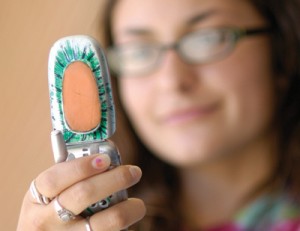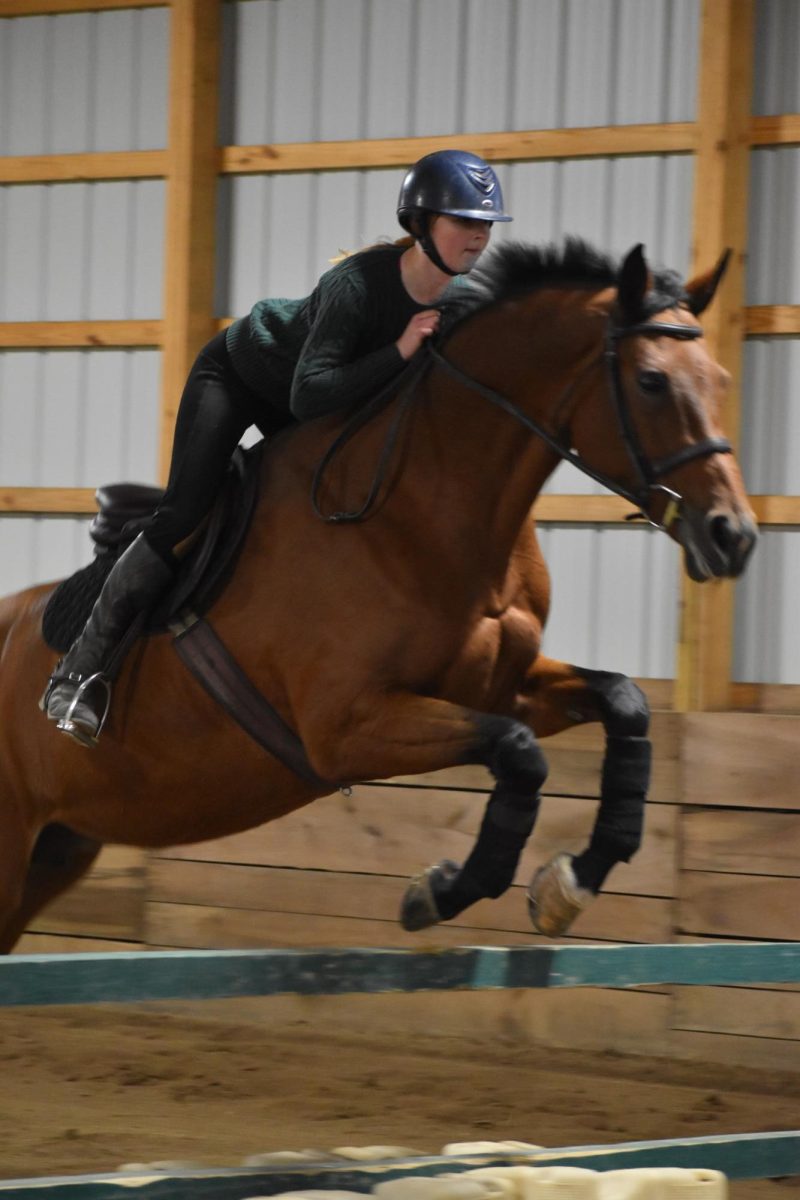
By Maddi Bourgerie
<[email protected]>
When junior Kelly Quinn is with friends she expects it to be a time to talk, catch up and hang out. The last thing she wants to see her friends doing during this time, she said, is sending text messages.
“When my friends text while they are hanging out with me, it is possibly in my top three pet peeves. It’s just rude and disrespectful,” she said. “When I am hanging out with someone it is because I want to, and when that person is texting it gives the impression that they would rather be talking to that person.” Quinn said she doesn’t text very often, only about five texts a day, and uses it for communication purposes. “That’s how it should be,” she said.
As for senior Kristen Neher, an avid texter who averages about 100 texts a day, she sees no problem with the continuous communication.
“Many people seem to get annoyed with me if I am texting while with them because they think I am not paying attention to them when really I am,” Neher said. “The only time I personally see it is rude is in church.”
For Neher, texting has just become a habit that fulfills a need for constant contact with others. She said that she uses it for both communication and chatting. It is also something to do when she’s bored.
Interpersonal relations teacher DeAnn Shrewsbury said that texting can be inappropriate in many situations and that there is a proper etiquette to texting.
“Texting is abused because it is not just used for communication but for chatting,” Shrewsbury said. “It can very easily become impolite. Texting while talking in a group, in a classroom or church is just unacceptable.”
Shrewsbury said she believes there is a proper etiquette to texting. “When in one of these inappropriate situations, the only way it would not be rude is if it is an important text or call. In that case you will need to remove yourself from the situation and take care of it,” she said.
Science teacher George Ohmer, who has been teaching for 35 years, gives an older perspective on the updated version of communication. Ohmer said that he rarely texts, but he believes there are times that it is more convenient and efficient to send a text message instead of a phone or voice message. He added that texting has evolved to a place among young people of a major form of everyday communication.
But teachers like Shrewsbury said they see other problems in texting. “One problem that I see is in the class work,” she said. “Students are abbreviating words instead of writing them out.”
According to Pew Internet and American Life Project, “60 percent of teens do not think of these electronic texts as ‘writing.’ Teens are utilitarian in their approach to technology and writing, using both computers and long hand depending on circumstances. Their use of computers for school and personal writing is often tied to convenience of being able to edit easily. Many do admit that the informal styles that characterize their e-communication do occasionally bleed into their schoolwork.”
Ohmer said texting is much less personal. “Cell phone contact is almost always a given priority over personal contact, which is rude on the part of the receiver of the message,” he said. “Many younger people spend hours texting their ‘contacts’ as a new form of communication. I believe that e-mail and texting have reduced the quality personal communication skills. Many verbal conversations are short, and the use of the word ‘like’ and the phrases ‘you know’ and ‘know what I’m saying’ are used excessively and improperly. I have also noticed an overall negative change in spelling and handwriting abilities probably due to electronic communication.”
As for Neher, she said she thinks some people express themselves better through text, but mostly because they don’t have the courage to say it in person.
Quinn said, “Texting is making this generation more distant, less personal and more vulnerable.”
___
TXT USRS BTN (BY THE NUMBERS) IN 2005
Close to half of teens (45 percent) own a cell phone, and 33 percent have used a cell phone to send a text message.
Almost one in three (29 percent) teens who use IM or text messaging will use it to communicate with their parents.
An average youth between ages 12 to 17 reports spending 10.3 hours a week with friends doing social activities outside of school and about 7.8 hours talking with friends via technology like the telephone, e-mail, IM or text messaging.
PEWINTERNET.ORG / SOURCE


































![British royalty are American celebrities [opinion]](https://hilite.org/wp-content/uploads/2024/03/Screenshot-2024-03-24-1.44.57-PM.png)



















![Review: Quiet on Set: The Dark Side of Kids TV is the long awaited exposé of pedophilia within the children’s entertainment industry [MUSE]](https://hilite.org/wp-content/uploads/2024/04/unnamed.jpg)
![Review: “The Iron Claw” cannot get enough praise [MUSE]](https://hilite.org/wp-content/uploads/2024/04/unnamed.png)
![Review: “The Bear” sets an unbelievably high bar for future comedy shows [MUSE]](https://hilite.org/wp-content/uploads/2024/03/unnamed.png)
![Review: “Mysterious Lotus Casebook” is an amazing historical Chinese drama [MUSE]](https://hilite.org/wp-content/uploads/2024/03/0.webp)
![Thea Bendaly on her Instagram-run crochet shop [Biz Buzz]](https://hilite.org/wp-content/uploads/2024/03/IMG_0165-1200x838.jpg)
![Review in Print: Maripaz Villar brings a delightfully unique style to the world of WEBTOON [MUSE]](https://hilite.org/wp-content/uploads/2023/12/maripazcover-1200x960.jpg)
![Review: “The Sword of Kaigen” is a masterpiece [MUSE]](https://hilite.org/wp-content/uploads/2023/11/Screenshot-2023-11-26-201051.png)
![Review: Gateron Oil Kings, great linear switches, okay price [MUSE]](https://hilite.org/wp-content/uploads/2023/11/Screenshot-2023-11-26-200553.png)
![Review: “A Haunting in Venice” is a significant improvement from other Agatha Christie adaptations [MUSE]](https://hilite.org/wp-content/uploads/2023/11/e7ee2938a6d422669771bce6d8088521.jpg)
![Review: A Thanksgiving story from elementary school, still just as interesting [MUSE]](https://hilite.org/wp-content/uploads/2023/11/Screenshot-2023-11-26-195514-987x1200.png)
![Review: When I Fly Towards You, cute, uplifting youth drama [MUSE]](https://hilite.org/wp-content/uploads/2023/09/When-I-Fly-Towards-You-Chinese-drama.png)
![Postcards from Muse: Hawaii Travel Diary [MUSE]](https://hilite.org/wp-content/uploads/2023/09/My-project-1-1200x1200.jpg)
![Review: Ladybug & Cat Noir: The Movie, departure from original show [MUSE]](https://hilite.org/wp-content/uploads/2023/09/Ladybug__Cat_Noir_-_The_Movie_poster.jpg)
![Review in Print: Hidden Love is the cute, uplifting drama everyone needs [MUSE]](https://hilite.org/wp-content/uploads/2023/09/hiddenlovecover-e1693597208225-1030x1200.png)
![Review in Print: Heartstopper is the heartwarming queer romance we all need [MUSE]](https://hilite.org/wp-content/uploads/2023/08/museheartstoppercover-1200x654.png)























![Review: Ladybug & Cat Noir: The Movie, departure from original show [MUSE]](https://hilite.org/wp-content/uploads/2023/09/Ladybug__Cat_Noir_-_The_Movie_poster-221x300.jpg)

![Review: Next in Fashion season two survives changes, becomes a valuable pop culture artifact [MUSE]](https://hilite.org/wp-content/uploads/2023/03/Screen-Shot-2023-03-09-at-11.05.05-AM-300x214.png)
![Review: Is The Stormlight Archive worth it? [MUSE]](https://hilite.org/wp-content/uploads/2023/10/unnamed-1-184x300.png)

